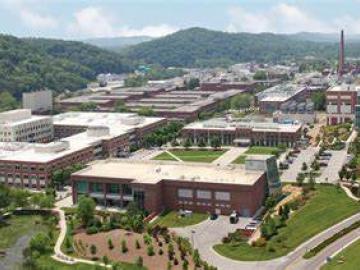Filter News
Area of Research
- Advanced Manufacturing (14)
- Biology and Environment (28)
- Building Technologies (2)
- Clean Energy (119)
- Climate and Environmental Systems (1)
- Computational Biology (1)
- Computational Engineering (2)
- Computer Science (12)
- Electricity and Smart Grid (2)
- Fusion and Fission (5)
- Fusion Energy (3)
- Materials (31)
- Materials for Computing (11)
- Mathematics (1)
- National Security (24)
- Neutron Science (13)
- Nuclear Science and Technology (3)
- Quantum information Science (7)
- Sensors and Controls (1)
- Supercomputing (72)
- Transportation Systems (2)
News Type
News Topics
- (-) 3-D Printing/Advanced Manufacturing (63)
- (-) Big Data (35)
- (-) Computer Science (115)
- (-) Grid (40)
- (-) Machine Learning (28)
- (-) Quantum Science (33)
- (-) Transportation (60)
- Advanced Reactors (19)
- Artificial Intelligence (51)
- Bioenergy (61)
- Biology (70)
- Biomedical (37)
- Biotechnology (12)
- Buildings (33)
- Chemical Sciences (26)
- Clean Water (26)
- Climate Change (63)
- Composites (14)
- Coronavirus (28)
- Critical Materials (12)
- Cybersecurity (17)
- Decarbonization (46)
- Emergency (1)
- Energy Storage (58)
- Environment (140)
- Exascale Computing (22)
- Fossil Energy (3)
- Frontier (20)
- Fusion (36)
- High-Performance Computing (49)
- Hydropower (11)
- Irradiation (2)
- Isotopes (28)
- ITER (5)
- Materials (71)
- Materials Science (67)
- Mathematics (6)
- Mercury (10)
- Microelectronics (2)
- Microscopy (30)
- Molten Salt (6)
- Nanotechnology (28)
- National Security (33)
- Net Zero (7)
- Neutron Science (70)
- Nuclear Energy (67)
- Partnerships (12)
- Physics (29)
- Polymers (15)
- Quantum Computing (18)
- Renewable Energy (1)
- Security (11)
- Simulation (28)
- Software (1)
- Space Exploration (21)
- Statistics (1)
- Summit (35)
- Sustainable Energy (78)
- Transformational Challenge Reactor (3)
Media Contacts

Rishi Pillai and his research team from ORNL will receive a Best Paper award from the American Society of Mechanical Engineers International Gas Turbine Institute in June at the Turbo Expo 2024 in London.

ORNL’s Omer Onar and Mostak Mohammad will present on ORNL's wireless charging technology in DOE’s Office of Technology Transitions National Lab Discovery Series Tuesday, April 30.

Held in Cocoa Beach, Florida from March 11 to 14, researchers across the computing and data spectra participated in sessions developed by staff members from the Department of Energy’s Oak Ridge National Laboratory, or ORNL, Sandia National Laboratories and the Swiss National Supercomputing Centre.

ORNL’s Erin Webb is co-leading a new Circular Bioeconomy Systems Convergent Research Initiative focused on advancing production and use of renewable carbon from Tennessee to meet societal needs.

ORNL scientists have spent the past 20 years studying quantum photonic entanglement. Their partnership with colleagues at Los Alamos National Laboratory and private industry partner Qubitekk led to development of the nation’s first industry-led commercial quantum network. This type of network could ultimately help secure the nation’s power grid and other infrastructure from cyberattacks.

Scientists at ORNL have developed 3D-printed collimator techniques that can be used to custom design collimators that better filter out noise during different types of neutron scattering experiments
ORNL scientists have determined how to avoid costly and potentially irreparable damage to large metallic parts fabricated through additive manufacturing, also known as 3D printing, that is caused by residual stress in the material.

An experiment by researchers at the Department of Energy’s Oak Ridge National Laboratory demonstrated advanced quantum-based cybersecurity can be realized in a deployed fiber link.

A team of researchers at ORNL demonstrated that a light-duty passenger electric vehicle can be wirelessly charged at 100-kW with 96% efficiency using polyphase electromagnetic coupling coils with rotating magnetic fields.

A team that included researchers at ORNL used a new twist on an old method to detect materials at some of the smallest amounts yet recorded. The results could lead to enhancements in security technology and aid the development of quantum sensors.




